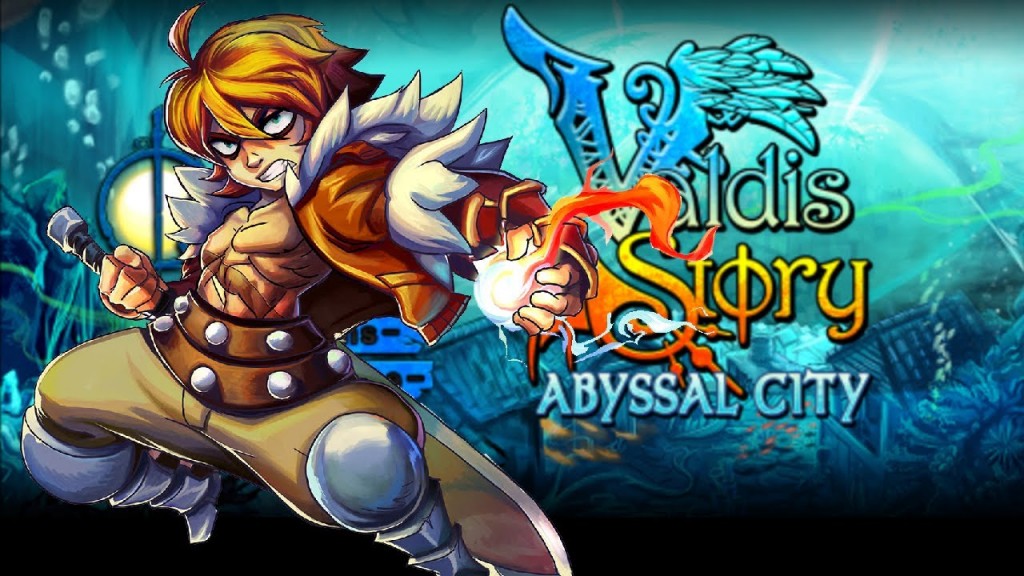Valdis Story: Abyssal City may be a silly name for a metroidvania action RPG, but this game is serious business. Caught in the crossfire between Myrgato’s demonic horde and Alagath’s angelic army, Valdis Story follows protagonist Wyatt Goibniu, a former ranking swordsman on the demonic side, after he performed a failed raid on Myrgato’s fleet. Falling beneath the sea, Wyatt wakes up in an underwater catacomb where the inhabitants live in fear of their very lives, disconnected from each other in various small villages.
Typically, when a ship sinks, it’s the end of the line, but EndlessFluff Games’ metroidvania starts its premise here: Find your crew from the failed raid, and stop the war between Myrgato’s demons and Algath’s angels. Additionally, players can also choose Reina (two more playable characters will be available after a free in-game update), a former angelic monk, as their protagonist, who has her own set of weapons, skills and abilities that differ from Wyatt’s. While this doesn’t change the content of the game, it certainly gives it a bit of replayability as you fight the two opposing factions in this gorgeous adventure title.
Valdis Story offers a rich sprawling environment filled with three villages and a variety of areas to explore. Comb the different locations through a combination of climbing, jumping, meele and magic and develop your own combat style by focusing on meele, magic, or a blend of the two disciplines. Due to the intercacies of the combat, button-mashing is not to be found in Valdis Story, or at least, not as an effective tactic. Precision is key, but the Xbox 360 gamepad, which I used in my playthrough, is unfortunately not quite built for that, and I sometimes struggled my way through combat due to the somewhat unresponsive control stick.
This came in mind particularly when trying to perform skill cancels, one of the game’s more noteworthy features. Skill cancels allow you to dodge attacks and shift to the opposite side of enemies by pulling off a Street Fighter style Hadouken (down, left/right on the control pad). It’s a great feature, and one that adds a lot to combat, it’s just frustratingly difficult to pull off with consistency, especially on a gamepad like the Xbox 360 controller. There’s a reason that no one plays fighting games on Xbox without an arcade stick, and Valdis Story‘s combat system just serves to reinforce this.
As far as the combat is concerned, where the game’s system really shines is in the boss battles. Bosses are quite difficult, often frustratingly so, and require great timing and strategy to defeat. Bosses range from Angelic, Demonic, and Feral (the third enemy type that naturally inhabits the underwater catacombs), and each boss requires a unique gameplan to beat. Most boss fights, even for the more veteran metroidvania players, will require at least a few tries to best, and experimentation in both combat and method is key to advancing beyond the boss battles.
Visually, the distinctive art style and the rich colors make the game a stunner to view. Despite the sometimes breathtaking amount of enemies on screen, the game never becomes too cluttered and consistently maintains a great-looking tone. The rock-inspired soundtrack only adds to this, with great tunes that seem reminiscent of Guilty Gear in the best possible sense.
Where the game seems to falter is in its lack of expounded narrative, particularly when talking to NPC’s. At a certain point, Valdis Story asks you to collect seemingly innocuous items for no real narrative purpose, and then fails to give specific directions as to how to obtain these items. I spent hours exploring every possible inch of the underwater catacombs, grinding my levels up to the stratosphere while failing to find the location of one of the two items. Only after consulting a walkthrough was I able to find the item, as the way was not sufficiently sign-posted and the NPC stubbornly refused to repeat any pertinent dialogue about the items to me. An in-game world map would have helped greatly, as the provided mini-map does not suffice in helping your navigation skills.
While Valdis Story is primarily combat-oriented, the game also has a heavy emphasis on platforming that is typically more frustrating than enjoyable, even for a metroidvania. Wall jumping scenarios where enemies are hacking at your feet or vomiting projectiles at you are nearly a dime a dozen, and most if not all of the puzzles revolve around skill canceling on pressure plates, only to have to run to the door through a hodgepodge of jumping and enemy dispatchment in the nick of time.
That being said, there’s still plenty to enjoy about Valdis Story: Abyssal City. It’s not perfect by any means, but the engaging combat system and immersion audio and visual components keep the game going at a breakneck pace. Additionally, there’s plenty of collectibles and customization options, so fans of the metroidvania genre are sure to enjoy this one. Just don’t expect a totally streamlined experience, at least not yet.











